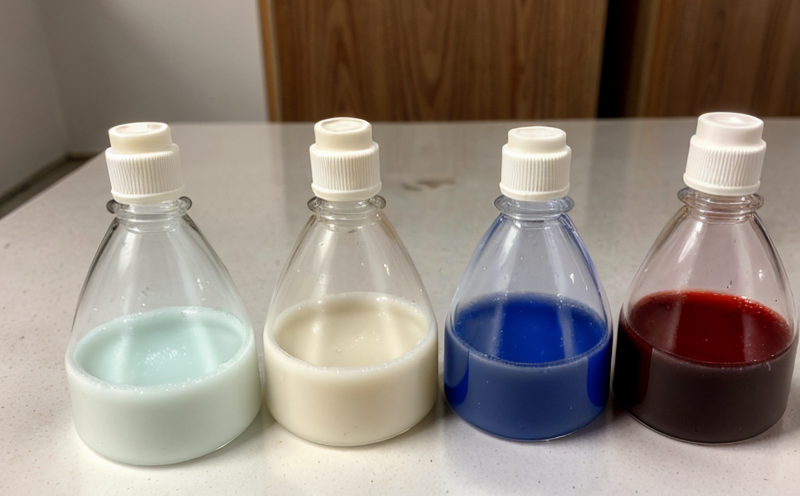AOAC 991 Phthalate Monomer Testing in Food Products
The AOAC Official Method 991 has been widely recognized as a robust and reliable procedure for detecting phthalate monomers in food products. These compounds, such as diethyl phthalate (DEP), dibutyl phthalate (DBP), and others, are often used in packaging materials, plasticizers, and other components of food contact items. The presence of these substances can pose significant health risks if they leach into the food matrix during storage or processing.
The AOAC 991 protocol involves several critical steps to ensure accurate detection. Initially, a sample preparation step is necessary where the food product is thoroughly homogenized and extracted using an appropriate solvent. The choice of solvent can vary based on the type of food being tested, but typically includes methanol or acetonitrile. After extraction, the solution undergoes purification to remove interfering components.
The purified extract is then analyzed via gas chromatography coupled with mass spectrometry (GC-MS). This instrumentation allows for precise identification and quantification of phthalate monomers present in the sample. The method's accuracy is further enhanced by calibration using certified reference materials, ensuring that results are reproducible and consistent across different laboratories.
The AOAC 991 protocol is not only a standard but also a benchmark for regulatory compliance. Regulatory bodies such as the FDA and EU member states often require adherence to this method when testing food products for phthalate monomers. Compliance with these standards ensures that manufacturers can demonstrate due diligence in protecting public health.
One of the key benefits of using AOAC 991 is its sensitivity, allowing detection levels as low as parts per billion (ppb). This high level of precision makes it particularly valuable for quality managers and compliance officers who need to ensure their products meet stringent safety standards. For R&D engineers, this method provides critical insights into potential contamination sources and helps in the development of safer food contact materials.
Another significant advantage is its reliability across different laboratories. The AOAC 991 protocol has been validated by numerous studies, ensuring consistent results regardless of the testing facility. This consistency is crucial for procurement teams who need to rely on accurate data when selecting suppliers and certifying products.
- High sensitivity, detecting phthalate monomers at parts per billion (ppb) levels.
- Robust and reliable method recognized by regulatory bodies worldwide.
- Consistent results across different laboratories ensuring reliability.
- Comprehensive data for quality managers to ensure product safety.
Benefits
- Ensures product safety by detecting phthalate monomers at parts per billion (ppb) levels.
- Satisfies regulatory requirements and ensures compliance with international standards.
- Provides consistent results across different laboratories, enhancing reliability.
- Supports research and development in identifying safer materials for food contact items.
The AOAC 991 method is a cornerstone of quality assurance programs. By ensuring that food products are free from harmful phthalate monomers, it helps protect public health and builds consumer confidence in the safety of food products.
Use Cases and Application Examples
The AOAC 991 method finds extensive use across various industries. Quality managers at food processing plants rely on this test to monitor incoming raw materials for contamination risks. Compliance officers use it as part of their routine audits to ensure ongoing adherence to regulatory standards.
- Quality control in food manufacturing facilities.
- Routine testing during product development and lifecycle management.
- Supplier certification programs where phthalate monomer levels are a key criterion.
- Post-market surveillance to detect any unexpected contamination issues.
In addition, this method is crucial for R&D teams working on developing new food contact materials. By identifying potential sources of contamination early in the development process, they can make informed decisions about material selection and formulation.
The AOAC 991 method also plays a vital role in ensuring compliance with international standards such as ISO, ASTM, EN, IEC, etc., which are essential for global trade. By adhering to these standards, manufacturers ensure that their products meet the highest safety and quality benchmarks.
Why Choose This Test
The AOAC 991 method stands out due to its unparalleled accuracy and reliability. Its ability to detect phthalate monomers at extremely low levels makes it a critical tool for ensuring product safety and compliance with international standards.
- High sensitivity, detecting phthalate monomers at parts per billion (ppb) levels.
- Robust and reliable method recognized by regulatory bodies worldwide.
- Consistent results across different laboratories ensuring reliability.
- Comprehensive data for quality managers to ensure product safety.
The AOAC 991 protocol is not just a standard; it is a benchmark that sets the industry's expectations. Compliance with this method ensures that manufacturers can demonstrate due diligence in protecting public health, thereby building consumer trust and maintaining a positive brand image.





